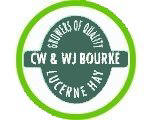 Hay
types available from The Farm
Hay
types available from The Farm
We produce lucerne, oaten, clover and permanent pasture hay, and these can be supplied in medium square bales, 80mm x 90 mm x 2400 mm (31.5 in x 35in x 8 ft), round bales. Small square bales are baled to order.
Balers used are, New Holland super 417 small square baler, New Holland BB940 medium square baler and John Deere 590 round baler.
Lucerne/Alfalfa hay.
Six cuts of lucerne are produced each season, depending on weather conditions, normally starting late October early November and continuing though to April.
All Lucerne is cut with a John Deere 1470 mower conditioner, we find this machine gives just the right amount of crimping to speed drying, without damaging leaves. The windrow is normally raked to increase size for baling, to retain colour and for even drying. The windrow is turned once more to retain colour and speed drying time. When cured it is baled either in square bales (big or small) or round bales to suit the customer.
Apart from mowing and carting, lucerne is handled either late at night, before the dew sets, or in the morning, as the dew rises. This maximises the retention of the leaf and makes for softer hay. In our climate it takes about five days to make top quality lucerne hay, there is a degree of skill and knowledge in making top quality lucerne hay, but luck with the weather plays a big part.
We cut most weeks of the season, so there will be hay of a quality and price to suit any industry use, from the fussiest horse owner to the dairy farmer that wants more milk in the vat or the beef farmer that wishes to top the market.
Oaten hay.
Oaten hay is handled with the same care as the lucerne in the mowing, raking and baling, making a high quality product for uses including chaffing, feedlotting and dry cow feeding.
Clover hay.
Pure clover hay or clover and rye grass hay are suitable for the horse industry, fatting both sheep and beef cattle and putting more milk in the vat for dairy farmers. Clover is handled in a slightly different way, as it is higher in moisture when cut, it requires a longer curing time. Supplies of clover hay can be limited at times as it is only cut once a year.
Permanent Pasture hay.
Permanent pasture hay is a mix of white clover and rye grass and can be cut more than once a season. The best quality is spring cut, while the clover and rye are young. Later cuts in the summer can have more summer grasses and are normally of a lower quality. We only cut in the spring to get the best quality. This hay is suitable for horses, sheep, beef cattle and dairy cattle.
